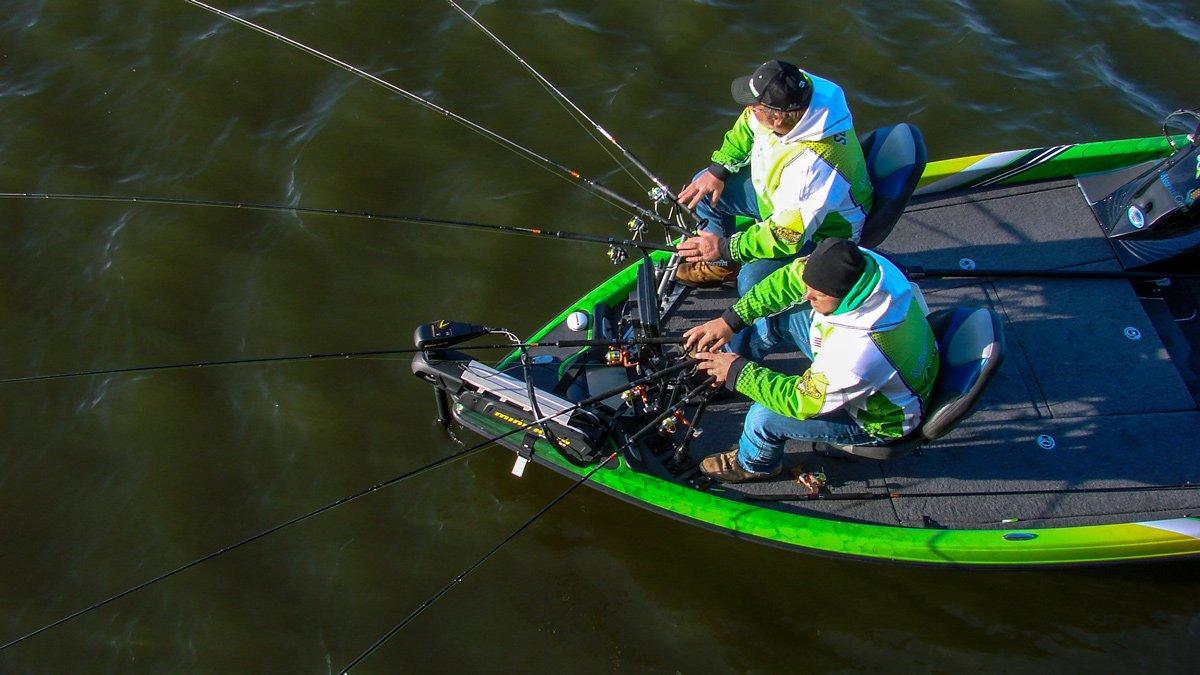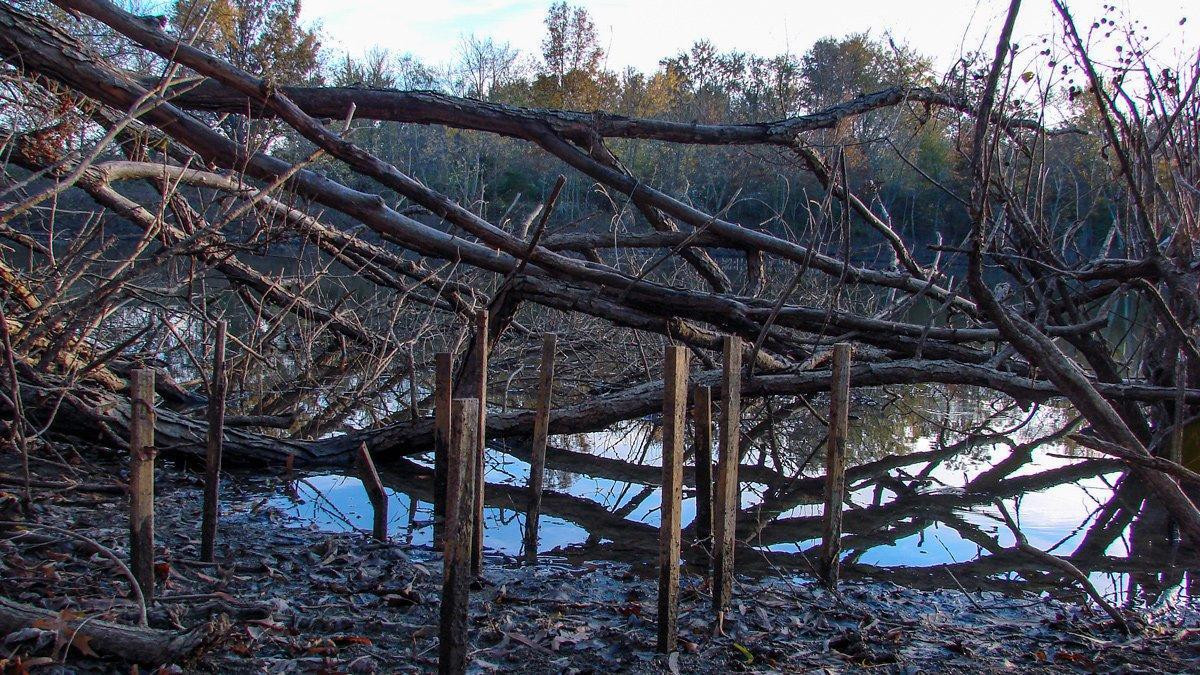The most exciting and challenging time of year to slow-troll would be late winter, when crappie are fattened up from their fall and winter gorging and on the move to shallower water to prepare for the spawn. Crappie are very active this time of year and fishermen who know how to find them are often in for a pole-slamming treat.
Kevin Jones has been crappie fishing for most of his life, fishing professionally since 2003. With multiple wins and top 10 finishes on lakes and rivers across the country, Kevin consistently catches crappie through all 4 seasons. Jones, a self-proclaimed “one-poler”, forced himself to learn multiple rod tactics to compete on the professional level. He’s since learned to love the tactics during late winter for wrangling shallow-water slabs.
GEAR FOR SLOW TROLLING
Crappie spook easily in shallow water, and without the right gear, anglers will often leave the lake with empty livewells and the belief that the fish just weren’t biting. When in fact, the crappie were probably swimming away before ever seeing their bait. These 4 gear considerations should alleviate that problem:
- The right rod – When crappie move into the shallows prior to the spawn, a long rod with a soft tip is the most important tool in your boat. Crappie in less than 5 feet of water are easily spooked with boat noise, so staying as far away from the trolling motor is necessary. Kevin uses the 16-foot B’n’M BGJP.
“The longer pole keeps the bait away from the boat, and the soft tip on the BGJP keeps tension off the fish during the first second or two after the bite,” Jones said. “I also see more bites, especially when they are light, with the softer tip.” - Reels make a difference – Without a smooth, lightly set drag, landing big, aggressive crappie in shallow water becomes very difficult. Kevin employs Quantum spinning reels and relies on their drag.
“I set the hook hard every time, and when big fish knock the line slack, a hard hookset can snap 12-pound mono, so the drag is very important,” Jones said. - Picking your bait – While live bait is always a solid option when spider-rigging, pairing it with large jigheads and plastics with oversized hooks will garner more bites from aggressive fish. Bright and contrasting colors are often effective, as well as glow baits.
“I use a Muddy Water 2 1/2-inch Hat Trick, which is a big, solid body plastic with a pin tail,” Jones said. “In shallow, cold water, I like bright colors like white and glow and ‘Pink Lemonade’ on a 1/4-ounce Roadrunner head.” - Ready with the net – Because of the inability of aggressive crappie to pull down, they instead “run” with bait, often causing poor hook-sets in the side or corner of the mouth. Utilizing a long, lightweight net that can get under the fish the second it surfaces is paramount.
Tactical adjustments
Longer poles aren’t the only alteration anglers use to target shallow-water crappie. Here are 4 tactical approaches to improve your odds:
- Stealth is key – Without stealth, hook-sets, proper nets, and the right baits are useless.
“I’ll move my trolling motor up as high as possible, and after locating the crappie will turn off my graph because of the noise it makes. The Power Poles are really handy when you’ve pinpointed crappie. I’ll ease up to cover and lower the poles by remote. If I’m covering an area and there’s a breeze, I’ll drop the Power Poles to just above the bottom with the paddle attachments to slow the boat down.” - Hands-on technique – To achieve a quick hookset to the top of the crappie’s mouth, anglers must detect the bite instantly. Keeping your hands on the butts of the rods will allow the same reaction-driven hooksets you get when holding a rod.
- Slow your roll – Although crappie can be very aggressive in late winter, they also congregate in small areas and moving too fast will cause you to miss strikes or pass by fish. Cold water also makes baitfish lethargic, and although the crappie will hit and run hard in shallow water after the bite, they are not prone to chasing the bait beforehand.
- Setting the hook – While keeping your hands on the rods will facilitate quick hooksets when that coveted “thump” occurs, many times shallow water fish will just “run”, burying rods in the water with the line angling out to one side or the other. Setting the hook hard and high gives you the best chance at getting a proper hookset, and hopefully your partner will have the net ready!
“I go straight up and set the hook hard. If you think it may be a bite, you never just lift the rod and check for tension, especially in shallow water because you’ll miss that fish most of the time. You have to commit to setting the hook and do it every time.”
Where to look
Jones offered 5 key places to slow troll shallow winter crappie:
- Covering the flats – “I’ll fish shallow flats that have cover, but I usually look for the areas close to the channel edge or a break,” Jones said. “I’ll scan the area and look for fish concentrated on cover and throw out a buoy marker, and then turn off my graph and fish.”
- Remember the spawn – Late winter and early spring crappie are moving back to areas where they spawn. Recalling last year’s spawn and working the areas around the beds or cover is one of the best spots to find big crappie, especially into late-winter and during the first warm fronts of the year.
- Bottom dwellers – “When crappie are right on the bottom in very shallow water, I’ll push a heavy jighead on bottom and will tie on a smaller jighead and bait above it. When crappie are really shallow, it isn’t unusual to find one fish on the bottom and the next one 6 inches below the surface.”
- Push the ledges – In lakes and rivers with steep banks, the ledges leading up to the shallows are excellent places to find late winter crappie. Pushing multiple baits in a wide swath parallel to the bank affords the angler to fish from shallow water to mid-level depths.
- Covering the cover – Shallow water cover can consist of a stake bed in 5 foot of water or a stick-up the size of your thumb in 3 foot of water. Crappie are extremely cover-oriented through most of the year, but late winter is the best time aside from the spawn to find them heavily congregated on small pieces of cover.
If you’ve ever wanted to try slow trolling for crappie, late winter is a great time to get started. Anyone who’s skeptical of the technique should try pushing eight 16-footers in 3 feet of water for angry 2-pound slabs, and then make your decision! If multiple rigs are not allowed in your state, add a guided trip to one of Mississippi’s “Big Four Fisheries” to your bucket list. I promise, you won’t regret it!















